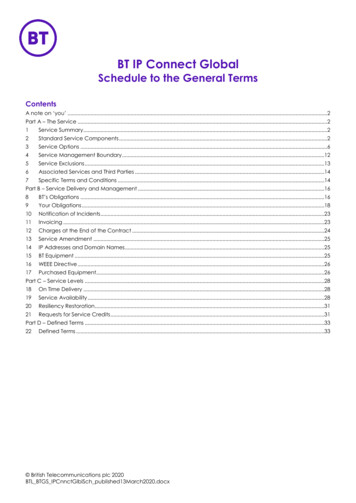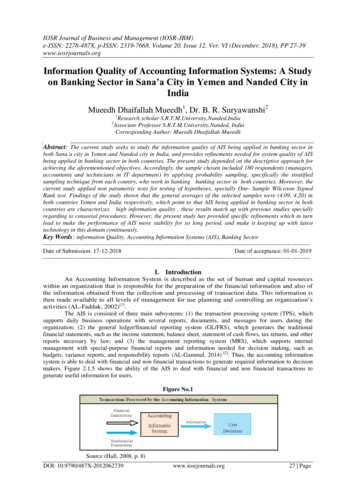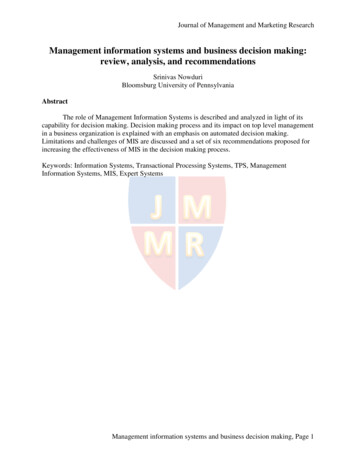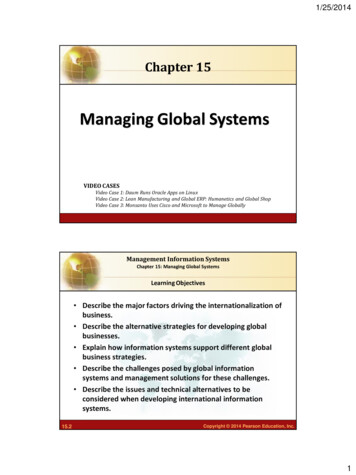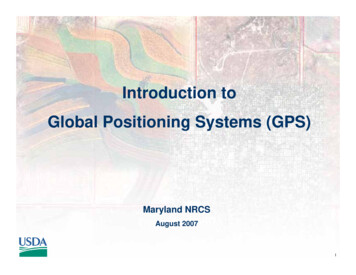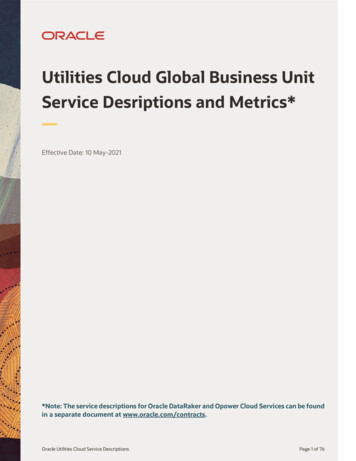
Transcription
Information ManagementGlobal Business andInformation SystemsChapter 1&2Lecturer: Dr Richard BoatengEmail: richard@pearlrichards.orgFeb 3rd 2010
Management Information SystemsVisit Nike ID – www.nikeid.comcreate your own shoe
Management Information Systems
Management Information SystemsWhat is an information system?
Management Information SystemsAn information system (IS) is an arrangement of people,data, processes, and information technology that interact tocollect, process, store, and provide as output the informationneeded to support an organization.Information technology is a contemporary term thatdescribes the combination of computer technology (hardwareand software) with telecommunications technology (data,image, and voice networks).
Management Information SystemsFigure 1 An Integrated View of Information and Communication TechnologiesHRISSource: Adapted from Duncome and Heeks (2001)
Management Information SystemsInformation Architecture and Information Technology Infrastructure
Management Information Systems Data: Streams of raw facts representing eventssuch as business transactions Information: Clusters of facts that are meaningfuland useful to human beings in the processes suchas making decisions
Management Information SystemsWhat Is an Information System?Data and Information
Management Information SystemsActivities in an Information SystemINPUTPROCESSFEEDBACKOUTPUT
Management Information SystemsFunctions of an Information SystemFigure 1-3
Management Information SystemsMore Qu1.What are the major types of systems in a business?What role do they play?2.How do information systems support the majorbusiness functions: sales and marketing,manufacturing and production, finance andaccounting, and human resources?
Management Information SystemsSix Types of Information Systems1. Executive SupportSystem (ESS)Strategic-Level2. Decision SupportSystems (DSS)3. Management InformationSystems (MIS)ManagementLevel4. Knowledge WorkSystems (OS)5. Office Systems (OS)6. Transaction ProcessSystems (TPS)KnowledgeLevelOperational-LevelPlan and Project,Forecast- Senior ManagersDecision Analysis;Summary Reports- Staff Managers &Middle ManagersModels; Graphics;Documents & Mail-Professionals &Clerical WorkersSorting; lists; DetailedReports; Pay Slips- OperationsPersonnel; Supervisors
Management Information SystemsSystems that Span the BusinessSAP ERP:Human Resource Systems - Leave RequestExampleExecutive Support Systems – Sales Planningand uite/erp/demos/index.epx
Management Information SystemsA transaction processing system (TPS) is an informationsystem that captures and processes data about businesstransactions.A management information system (MIS) is aninformation system that provides for management-orientedreporting based on transaction processing and operations ofthe organization.A decision support system (DSS) is an information systemthat either helps to identify decision making opportunities orprovides information to help make decisions.
Management Information SystemsAn expert system is an information system that capturesthe expertise of workers and then simulates that expertise tothe benefit of nonexperts.A communications and collaboration system is aninformation system that enables more effectivecommunications between workers, partners, customers, andsuppliers to enhance their ability to collaborate.An office automation system is an information system thatsupports the wide range of business office activities thatprovide for improved work flow between workers.
Management Information SystemsSo what is the DIGITAL FIRM?
Management Information SystemsA firm which uses information systems tobecome networked and decentralized and todigitalize their business processes and fosterinnovation and creativity.
Management Information SystemsThe Internet:Reducing Boundaries and Competingon Information
Management Information SystemsThe Internet International network of networks Universal technology platform: Any computer cancommunicate with any other computer World Wide Web and Websites
Management Information SystemsThe Competitive Business Environment and the Emerging Digital Firm4 Major Systems Defining the Digital Firm Supply chain management systems Customer relationship management systems Enterprise systems Knowledge management systems
Management Information Systems Video Sessions I-800 Flowers (http://www.1800flowers.com)for video: http://news.zdnet.com/2422-12794 22-334892.htmlBlue Nile(http://www.bluenile.com) for video: http://news.zdnet.com/2422-12794 22-334950.html
Management Information SystemsTOWARD THE DIGITAL FIRM I-800 FlowersA network of 9000 floristsMobile (device) serviceCall CentreBlogsUser Experience- 75 % Customers from Web- Visual Experience- Portray the beauty of products- Easy Experience, comfortable- Efficient Blue Nile 60,000 jewelry3-4 days delivery timesUnique products need uniquetechnologyUser Experience- Understand GenderPreferences- Women do the selection Mendo the buying-Competitive Price – nomiddlemen/commissionsAvailability: 24/7
Management Information SystemsRole of Information SystemsEnablingSupportingProcesses andFunctions inOrganizationsProcesses andFunctions inOrganizationsThe websites of these companies enablethe sale of products. These companiesprimarily do not have anyshops/showrooms for consumers or mayfail to operate efficiently withouttheir websites.The websites of thesecompanies support the saleof electronic products whichare primarily done in theshops
Management Information Systems Electronic Commerce: Sharing business information, Electronic Business: Executing all the firm’s business Intranet: Business builds private, secure network based on Extranet: Extension of intranet to authorized external usersmanaging business relationships and facilitating transactions withInternet technology. (linking buyers and sellers).processes with Internet technology. (sales, finance, humanresources, manufacturing)Internet technology
Management Information SystemsTransformation of the Business Enterprise FlatteningDecentralizationFlexibilityLocation independenceLow transaction and coordination costsEmpowermentCollaborative work and teamwork
Management Information SystemsBusiness Perspective of Information ior, middle, operationalHardwareSoftwareStorage
Management Information SystemsOrganizationsKey Elements: People: Managers, knowledge workers, dataworkers, production or service workers Structure: Organization chart , groups of specialists,products, geography
Management Information SystemsOrganizations Operating procedures: Standard operating procedures(SOP, rules for action) Politics: Power to persuade, get things done Culture: Customs of behavior
Management Information SystemsManagementLevels: Senior managers: make long-range strategic decisionsabout products and services Middle managers: Carry out the programs and plans ofsenior management Operational managers: monitor the firm’s daily activities
Management Information SystemsComputer TechnologyTools managers use to cope with change Hardware: Physical equipment Software: Detailed preprogrammed instructions Storage: Physical media forstoring data and the software
Management Information SystemsSo what is the DIGITAL FIRM?
Management Information SystemsA firm which uses information systems to becomenetworked and decentralized and to digitalize theirbusiness processes and foster innovation andcreativity.
Management Information SystemsHow Digital is your firm?Highly talizationLess networkcentralization
Management Information SystemsVisit Nike ID – www.nikeid.comcreate your own shoe
Management Information Systems
Management Information SystemsFurther Examples of the MajorTypes of Systems inOrganizations
Management Information SystemsFour powerful worldwide changes that have altered thebusiness environment:1.2.3.4.Emergence of the Global EconomyTransformation of Industrial EconomiesTransformation of the Business EnterpriseThe Emerging Digital Firm
Management Information SystemsMajor Types of Systems in OrganizationsTypical Applications of Transaction Processing Systems (TPS)
Management Information SystemsMajor Types of Systems in OrganizationsHow management information systems obtain their datafrom the organization’s TPS
Management Information SystemsMajor Types of Systems in OrganizationsFour Major Types of SystemsTransaction Processing Systems (TPS) Basic business systems that serve the organization’soperational levelInput:Transactions, eventsProcessing: Sorting, listing, merging, updatingOutput: Detailed reports, lists, summariesUsers: Operations personnel, supervisors
Management Information SystemsEnterprise ApplicationsKnowledge Management Systems in the Enterprise Knowledge Management Systems (KMS)Collect relevant knowledge and experience in firm tosupport business processes and management decisionsManage and distribute documents and other digitalknowledge objects
Management Information SystemsEnterprise ApplicationsKnowledge Management Systems in the Enterprise Role of Knowledge Management SystemsAcquire knowledgeStore knowledgeDistribute knowledgeApply knowledge
Management Information SystemsMajor Types of Systems in OrganizationsFour Major Types of SystemsManagement Information Systems (MIS) Serve management level; provide reports and access tocompany dataInput: Summary transaction data, high-volume data, simplemodelsProcessing: Routine reports, simple models, low-levelanalysisOutput: Summary and exception reportsUsers: Middle managers
Management Information SystemsMajor Types of Systems in OrganizationsFour Major Types of SystemsDecision-Support Systems (DSS) Serve management level with data analysis for makingdecisionsInput: Low-volume data or massive databases, analyticmodels, and data analysis toolsProcessing: Interactive, simulations, analysisOutput: Special reports, decision analyses, responses toqueriesUsers: Professionals, staff managers
Management Information SystemsMajor Types of Systems in OrganizationsFour Major Types of SystemsExecutive Support Systems (ESS) Provide communications and computing environment thatserves the organization’s strategic levelInput: External and internal aggregate dataProcessing: Graphics, simulations, interactiveOutput: Projections, responses to queriesUsers: Senior Managers
Management Information SystemsMajor Types of Systems in OrganizationsModel of a typical executive support system
Management Information Systems Thank You for ListeningContact: richard@pearlrichards.org Website: www.pearlrichards.org48
Management Information Systems Visit Nike ID www.nikeid.com create your own shoe. Management Information Systems. Management Information Systems What is an information system? Management Information Systems An information system (IS) is an arrangement of people, data, processes, and information technology that interact to collect, process, store, and provide as output the information
